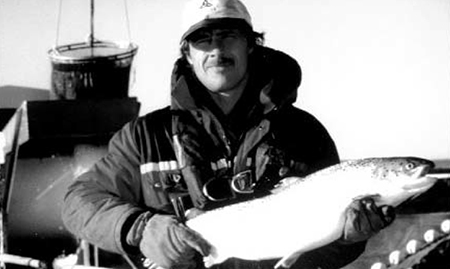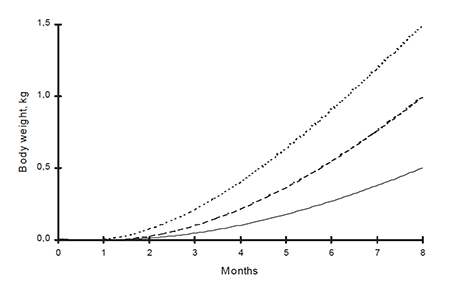Introduction
Well-designed breeding programs based on selection will increase productivity and reduce production cost in fish and shellfish commercial culture. The most obvious benefits are increased growth rate, reduced mortality, and better utilization of available feed resources. Establishing and running a breeding program requires capital and operating costs. However, the pay off can be remarkably high. For example, the cost/benefit ratio in the Norwegian breeding program for Atlantic salmon is on the order of 1/15. Therefore, it is difficult to understand why the aquaculture industry hesitates to initiate widespread breeding programs in aquaculture.

The major problem in aquaculture production based on wild broodstock or fry is unpredictability. Under these conditions, the availability of seed will be irregular and with large quality variation. The animals will be of unknown genetic origin and with unknown health status.
Furthermore, no domestication can take place when the production is based on wild stocks. Therefore, it is important for a sustainable industry to complete the life cycle in captivity and to establish a system for production of high quality broodstock by means of selective breeding. To illustrate the possibilities for improved production, following are results obtained for Atlantic salmon, tilapia, and penaeid shrimp.
Genetic gain with Atlantic salmon
The National breeding program for Atlantic salmon in Norway was initiated by AKVAFORSK in 1971. Because the generation interval is four years, it was necessary to establish four populations, which were produced from 40 wild Norwegian salmon strains. The first selection for growth rate took place in 1975, and was based on combined family and within family selection. In 1983 the breeding goals were extended to include age of sexual maturation to reduce the frequency of grilse.
Disease resistance (based on challenge tests for one bacterial and one viral disease) was included in 1992, fillet color was included in 1993, and in 1995 fat content and fat distribution were added to the breeding goals. Altogether, seven traits are included today in the goals for this breeding program.
Because family selection has always been applied, tagging of fingerlings has been important. The tagging system originally used (a combination of cold branding and fin clipping) limited the number of tested families each year to 120. During the last years the tagging system has changed to electronic tags (passively induced transponders), and thereby the number of families tested each year could be increased and is now about 400.
Selection has been completed for six generations for all populations, with a documented genetic gain of 10-12 percent for growth rate per generation. This means that the improved salmon is 80 to 100 percent heavier at marketing compared with wild salmon. For age at sexual maturation, the progress is about 10 percent. Selection for growth rate has indirectly increased feed consumption by 40v and feed conversion rate has been reduced by 20 percent. This increased efficiency is caused by a reduced maintenance requirement and an increased retention rate of 8 to 14 percent for energy and protein.
Genetic gain for disease resistance has not yet been estimated because of lack of genetic control groups, but the prospects are very good because the genetic variation is large for the involved diseases, and because repeated estimates of the genetic correlation between growth rate and survival have been found to be positive (0.3). The progress in Norwegian salmon farming has been remarkable: time to reach the market size of 4 kg today takes 20 to 25 months, compared to 35 to 40 months in the 1970s. Feed conversion ratio has been reduced to 1.1 as an average for the industry, and the cost of production per kg body weight has been reduced from U.S.$4.60 to $1.90 during the last 12 years.
Tilapia

The GIFT project (Genetic Improvement of Farmed Tilapia) was carried out in the Philippines between 1988 and 1997 by ICLARM, AKVAFORSK and two Philippines institutions, the Bureau of Fisheries and Aquatic Resources, and the Freshwater Aquaculture Center of Central Luzon State University.
The purpose of the project was to increase tilapia growth rate by selection. The base population was constituted from eight strains, four local and four imported directly from Africa (Egypt, Ghana, Senegal and Kenya). A combined family and within family selection program for growth rate was carried out.
Annually, about 20,000 tagged fish from 120 to 183 full-sib families (50 to 100 half-sib) were evaluated in a variety of test-environments. The phenotypic variation in growth rate was large, and the heritability was estimated to be 0.15.
During the project, selection was carried out once a year during five generations. The average selection response in growth rate per generation was 13 percent and the accumulated response was 85 percent. Fig. 1 illustrates the effect increased growth rate has on production. When growth rate is doubled, the fish reach market size after less than six months compared with eight months in the base population. When growth rate is three times the base population, it takes only four months to reach market size.
Penaeid shrimp
The Oceanic Institute (Hawaii, U.S.), in cooperation with AKVAFORSK, carried out a selection experiment with Litopenaeus vannamei during 1994 to 1997. The selection criteria were growth rate and resistance against Taura Syndrome Virus (TSV). The base population was constituted by crossing already established Specific Pathogen Free (SPF) lines.
Phenotypic variation in growth rate was relatively low, but the estimated heritabilities of 0.50 based on maternal half-sibs and 0.45 for full-sibs were quite high. Differences between families in surviving the challenge test were also significant, and the heritability was estimated to be 0.22 based on maternal half-sibs and 0.35 based on fullsibs. After one generation of selection, a genetic gain of 4.4 percent was estimated for harvest weight and of 12.4 percent for survival after the challenge test.
In Colombia, a breeding program was started in 1997 by the Corporation Center for Aquaculture Research in Colombia (CENIACUA, Corporación Centro de Investigacion de la Acuicultura de Colombia) in cooperation with AKVAFORSK. The goals are to improve resistance against TSV and growth rate in L. vannamei (Suarez et al. 1999). Three batches of 52 to 70 families are tested annually. The first batch showed large genetic variation in growth rate (h2 = 0.40) and intermediate variation for pond survival (h2 = 0.13). A significant genetic correlation between growth rate and pond survival was found.
Developing breeding programs
Based on present knowledge, one can strongly recommend that breeding programs are started for species with substantial production potential in aquaculture. However, detailed breeding plans must first be worked out. The work can be organized by official institutions, farmers associations or private companies, or as collaborate efforts. Investments are necessary to establish testing facilities and to maintain broodstock.
Running costs will include labor, feed, data handling, estimation of breeding values, selection of broodstock and others. To cover these expenses income can be obtained by selling seed, fry and broodstock of improved animals to the farmers at a higher price. It should be emphasized that it will take time to organize systems for dissemination and to build up marked for improved stock.
Conclusions
The genetic progress obtained so far for the three species described above is a representative example of the possibilities to increase productivity by selective breeding programs in other species.
Genetic gain:
- A genetic gain of 10 to 15 percent per generation when selecting for increased growth rate is possible and is well documented in various species. Consequently, growth rate can probably be doubled in five to six generations.
- A genetic gain of 10 percent per generation when selecting for disease resistance by applying challenge tests can be expected.
- When selecting for change in age at sexual maturation, the expectation of genetic gain is around 10 percent per generation.
- Other economically important traits in aquatic species also show genetic variation and should be expected to respond to selection.
Consequences of genetic gain:
- Faster growth will reduce time to market size and the turnover rate will be reduced.
- Survival rate will increase because disease resistance is improved and because of the shorter time to reach market size.
- Feed conversion rate will be improved because faster growth reduces the maintenance requirement and because improved animals are more efficient feed converters.
- Retention rate of energy and protein will be improved.
- Available feed resources will be better utilized by using improved stock.
- Cost of production will be reduced.
(Editor’s Note: This article was originally published in the December 1999 print edition of the Global Aquaculture Advocate.)
Now that you've finished reading the article ...
… we hope you’ll consider supporting our mission to document the evolution of the global aquaculture industry and share our vast network of contributors’ expansive knowledge every week.
By becoming a Global Seafood Alliance member, you’re ensuring that all of the pre-competitive work we do through member benefits, resources and events can continue. Individual membership costs just $50 a year. GSA individual and corporate members receive complimentary access to a series of GOAL virtual events beginning in April. Join now.
Not a GSA member? Join us.
Author
-
Trygve Gjedrem
Institute of Aquaculture Research
AKVAFORSK
1432 Aas, Norway
Tagged With
Related Posts

Health & Welfare
Advances in tilapia nutrition, part 2
Nutrition has an important role on growth, performance and flesh quality of tilapia. Part two of this two-part series looks into mineral supplementation and feeding strategy.

Health & Welfare
Genetic improvement of marine fish
Aquaculture often fails to enhance productivity and competitiveness with genetic improvement, perhaps due to uncertainty over which methods should be used.

Health & Welfare
Genetic markers help track soy protein utilization in shrimp
Recent research by the authors discovered genetic markers for the identification of Pacific white shrimp with enhanced capability to convert soy protein in feed.

Health & Welfare
Tilapia genetics: Applications and uptake
Although tilapia genetics lag behind crop and livestock breeding, the pace of development may narrow the gap appreciably in coming years.


